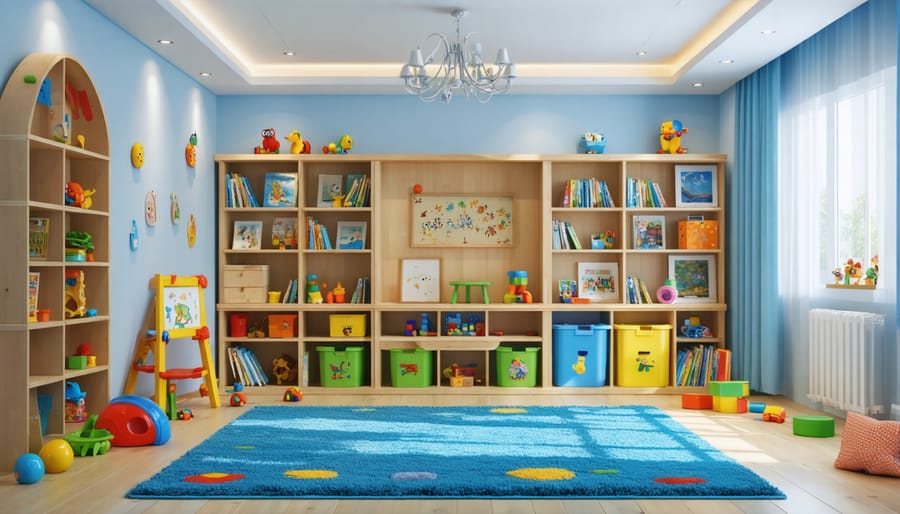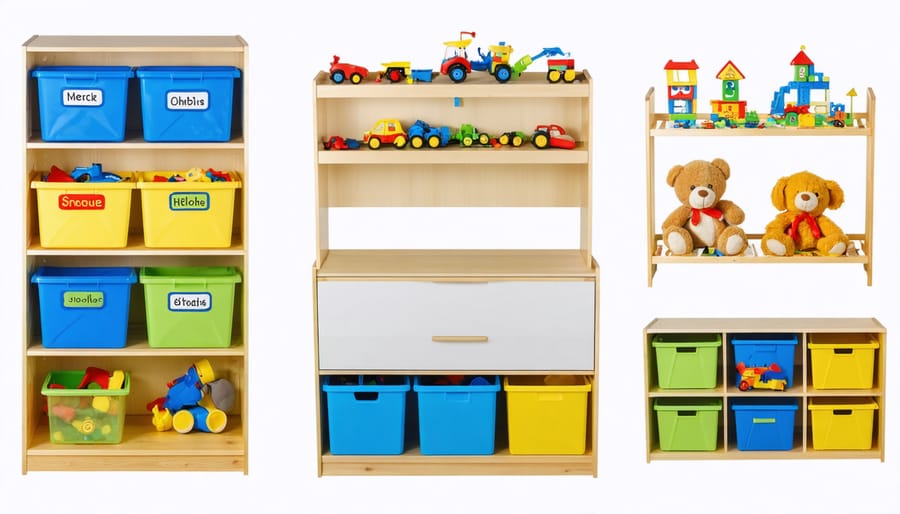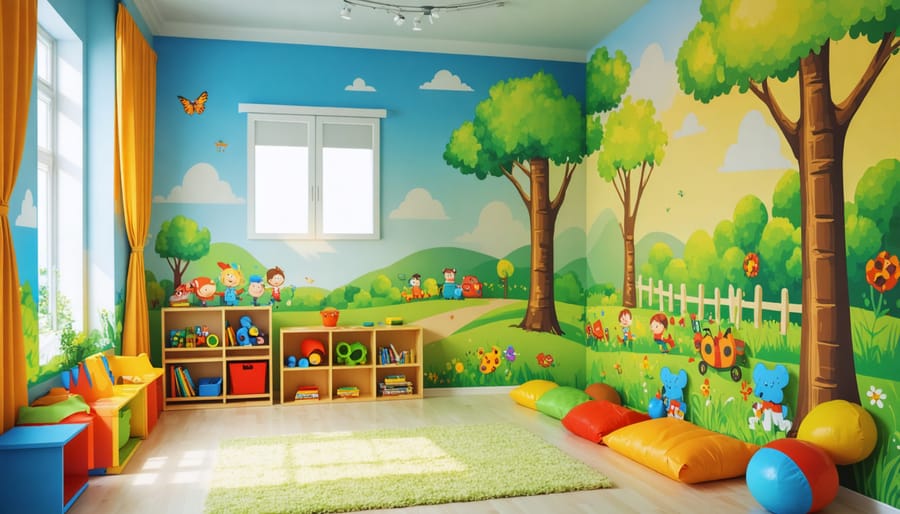Transform your child’s playroom into a magical learning haven that sparks creativity and supports healthy development. A well-designed playroom does more than contain toys – it creates an environment where imagination flourishes and organizational habits form naturally. Start by mapping your space into distinct activity zones: a cozy reading nook with floor cushions and accessible bookshelves, an active play area with safe climbing elements, and a creative corner equipped with art supplies and child-height tables. Factor in smart storage solutions like labeled bins and rotating toy displays to prevent overwhelming choices while teaching organization skills. Whether you’re working with a dedicated room or carving out a play space within a larger area, thoughtful playroom design can create a safe, stimulating environment that grows with your child and makes cleanup time a breeze.
Smart Space Planning for Maximum Fun & Safety
Activity Zone Planning
Creating distinct activity zones in your playroom helps children stay organized and engaged while making it easier to transform your space as their interests evolve. Start by mapping out key areas based on different types of play: quiet, active, creative, and learning zones.
For the quiet zone, set up a cozy reading nook with soft cushions, a small bookshelf, and perhaps a tent or canopy. This area should be away from noisier activities to encourage focus and relaxation.
Designate an active play zone with open floor space for physical activities. Use foam mats or soft carpeting for safety, and consider adding climbing elements or a mini basketball hoop if space permits.
Create an art station in the creative zone with an easy-clean table, storage for supplies, and a display area for finished masterpieces. Include washable markers, crayons, and paper within easy reach.
For the learning zone, incorporate a child-sized desk or table, educational materials, and perhaps a wall-mounted alphabet chart or world map. Keep this area well-lit and organized to promote concentration.
Use furniture placement and area rugs to naturally define these zones, and consider adding visual boundaries like different paint colors or removable wall decals to help children identify each area’s purpose.

Traffic Flow & Accessibility
When designing a playroom, traffic flow and accessibility are crucial elements that impact both safety and functionality. Create clear pathways at least 3 feet wide between activity zones to prevent congestion and allow children to move freely without bumping into furniture or each other. Position frequently used items like art supplies and favorite toys at child height, using open shelving or labeled bins that little hands can easily reach.
Consider the room’s entry points and ensure there’s a direct, unobstructed path to essential areas like the bathroom or exit. Avoid placing large furniture pieces that could create blind spots or cramped corners where accidents might occur. If you’re working with a smaller space, opt for multi-functional furniture that can be easily moved or folded away when needed.
For younger children, establish a clear line of sight across the room so you can supervise activities from any position. Place messy activity areas like craft tables near storage and cleaning supplies for quick access. Remember to keep electrical outlets covered and ensure window treatments have cordless options for enhanced safety.
Keep floor space open in the center of the room to accommodate active play and group activities. This arrangement naturally creates a circular flow that encourages movement while maintaining organization and safety.
Essential Safety Features Every Playroom Needs
Furniture & Equipment Safety
When selecting furniture for your playroom, safety should always be your top priority. Start by choosing pieces with rounded edges and smooth surfaces to prevent injuries from sharp corners. Opt for sturdy, low-profile furniture that won’t tip easily, and ensure all items are age-appropriate for your children.
Secure all tall furniture, including bookcases, storage units, and entertainment centers, to the wall using anti-tip brackets or straps. This simple step prevents devastating accidents from furniture toppling over. For additional security, install drawer stops to prevent drawers from being pulled out completely.
Choose play equipment that’s appropriately sized for your space and meets current safety standards. Climbing structures should have proper padding underneath and adequate clearance from walls and other furniture. If you’re including items like mini slides or play tunnels, ensure they’re firmly anchored and regularly check for stability.
Consider soft furnishings like bean bags and floor cushions, which provide comfortable seating without safety concerns. For tables and activity surfaces, look for pieces with protective corners or add corner guards to existing furniture. Keep electrical cords tucked away and use outlet covers for any unused electrical outlets.
Remember to regularly inspect all furniture and equipment for wear and tear, loose parts, or potential hazards. Create clear pathways between play areas and maintain proper spacing between furniture pieces to prevent tripping hazards. These thoughtful safety measures will help create a secure environment where children can play freely and confidently.
Childproofing Essentials
Creating a safe playroom starts with implementing essential childproofing measures. Begin by securing all furniture to the walls using anti-tip straps, particularly tall pieces like bookcases and storage units. Cover all electrical outlets with safety plugs, and ensure that electrical cords are either hidden behind furniture or secured with cord clips to prevent tripping hazards.
Install safety latches on cabinets and drawers, especially those containing art supplies or cleaning materials. Choose rounded furniture corners or add corner guards to protect little ones from sharp edges. Window treatments should be cordless or have cord cleats installed at an adult’s height to prevent strangulation risks.
For flooring, opt for impact-absorbing materials like foam tiles or thick area rugs with non-slip backing. If your playroom has stairs, install sturdy gates at both the top and bottom. Keep toys age-appropriate and regularly inspect them for loose parts or damage.
Consider mounting heavy items like TVs directly to the wall, and ensure all wall decorations are securely fastened using proper mounting hardware. Keep a first-aid kit nearby but out of children’s reach, and post emergency numbers in a visible location.
Remember to get down to your child’s eye level when checking for potential hazards – this perspective often reveals safety concerns that aren’t visible from an adult’s height. Regular safety checks should become part of your routine maintenance schedule.

Storage Solutions That Work
Age-Appropriate Organization
Creating storage solutions that evolve with your child is essential for a well-organized playroom that stands the test of time. Start with adjustable shelving units that can be modified in height as your child grows taller. Consider using modular cube storage systems, which can be reconfigured to accommodate changing needs, from storing large toys during toddler years to books and craft supplies for school-age children.
Label storage bins with both pictures and words to help young children identify where items belong while building early reading skills. As they grow, switch to written labels only. Choose storage furniture that can serve multiple purposes – like a bench with storage that works for toy cars now but can later hold gaming equipment or school supplies.
Install hooks and pegs at various heights that can be adjusted upward as your child grows taller. Consider implementing a rotating toy system using clear containers, making it easy to swap out age-appropriate toys while keeping others in storage. This approach not only maintains organization but also keeps the space fresh and engaging as your child’s interests and abilities develop.
Cleanup-Friendly Design
Making cleanup a breeze starts with smart design choices that encourage children to participate in organizing their space. Install low, open shelving units where kids can easily reach and return their toys. Label storage bins with both pictures and words, helping little ones understand where everything belongs while supporting early literacy skills.
Consider implementing a zone system where different activities have dedicated cleanup stations. Art supplies go in one area, building blocks in another, and dress-up clothes in their own special spot. This systematic approach helps children develop organizational skills and makes tidying up feel less overwhelming.
Make cleanup time fun by incorporating elements like a “cleanup countdown clock” or a sorting game where kids race to put toys in their correct homes. Install hooks at child height for bags and dress-up clothes, and use rolling storage bins that kids can easily move around during playtime and cleanup.
Remember to keep the system simple – the easier it is to clean up, the more likely children will participate. Regular decluttering sessions help maintain an organized space and teach children valuable lessons about managing their belongings.
Design Elements That Spark Joy & Learning
Color & Theme Selection
Selecting the right colors and theme for your playroom can significantly impact your child’s mood, creativity, and development. Start with a base of neutral colors like warm white or light gray, which provide a calm foundation and make the space feel larger. Then, introduce 2-3 accent colors that are both stimulating and balanced.
Primary colors (red, blue, and yellow) are classic choices for playrooms, as they’re easily recognizable and help with early learning. However, consider softer versions of these hues to prevent overstimulation. Pastel shades like mint green, sky blue, or gentle yellow create a soothing atmosphere while maintaining playfulness.
When choosing a theme, think long-term and opt for something that can grow with your child. Nature-inspired themes like forests, ocean life, or space exploration tend to have lasting appeal. Consider using removable wall decals or artwork rather than permanent murals, allowing you to update the theme as your child’s interests evolve.
For a cohesive look, carry your chosen colors through different elements: storage bins, throw pillows, play mats, and window treatments. Remember that the theme doesn’t need to overwhelm the space – subtle touches often work better than full-room transformations. This approach allows for easier updates and prevents the room from feeling too busy or chaotic.
Balance is key – aim for a space that’s engaging enough to inspire play but calm enough to prevent overstimulation during quiet activities.
Educational Design Features
A well-designed playroom can double as an engaging learning environment when you thoughtfully incorporate educational design elements. Start by creating designated zones for different types of learning activities. Set up a cozy reading nook with floor cushions and accessible bookshelves to encourage literacy. Include a mini art station with an easel, washable markers, and display space for creative works to foster artistic expression.
Consider adding a magnetic wall or chalkboard paint section for hands-on learning experiences. This space can be used for practicing letters, numbers, or displaying educational posters. Install low-mounted pegboards or activity walls that help develop fine motor skills through interactive play.
For cognitive development, incorporate storage units with clear labels and picture guides, helping children learn organization while making cleanup fun. Use color-coded zones to teach color recognition and create natural divisions between activity areas. Add educational rugs featuring maps, alphabets, or number games to make learning part of the floor space.
Don’t forget to include a small table and chairs for crafts, puzzles, and other focused activities. Consider rotating educational toys and materials seasonally to maintain interest and create new learning opportunities. Remember to keep everything at child height to promote independence and engagement with these learning elements.

Budget-Friendly Design Tips
Creating an amazing playroom doesn’t have to break the bank. With some creative budget-friendly design ideas, you can transform any space into a delightful play area. Start by repurposing existing furniture – an old bookshelf can become a toy display, while colorful bins from the dollar store make perfect organizers.
Paint is your best friend when it comes to affordable transformations. Create an accent wall with chalkboard paint for endless creative possibilities, or use washable paint in bright colors to define different activity zones. Consider using removable wall decals instead of expensive murals – they’re cost-effective and can be changed as your child grows.
Shop smart by visiting thrift stores and yard sales for gently used furniture and toys. Many classic pieces can be refreshed with a coat of paint or new hardware. For storage, use fabric cubes and plastic containers instead of expensive custom solutions. Create reading nooks using floor pillows and hanging a simple canopy made from affordable fabric.
Get creative with DIY projects. Make your own sensory wall using everyday items like buttons, zippers, and textured materials. Transform cardboard boxes into play kitchens or rocket ships with some paint and imagination. Use washi tape to create road tracks on the floor or geometric patterns on walls – it’s removable and incredibly affordable.
Remember to involve your children in the decoration process. Their artwork can become free wall décor when displayed in inexpensive frames. Look for sales and seasonal clearances to stock up on craft supplies and storage solutions. With thoughtful planning and creativity, you can create an engaging playroom that sparks joy without emptying your wallet.
Creating the perfect playroom doesn’t have to be overwhelming or expensive. By focusing on safety, organization, and creativity, you can design a space that both children and parents will love. Remember to start with a solid plan, incorporating age-appropriate elements that can grow with your child. Choose durable materials, implement smart storage solutions, and create distinct activity zones to maximize the room’s potential.
Don’t be afraid to let your creativity shine while maintaining functionality. Whether you opt for a reading nook, art station, or active play area, ensure each element serves a purpose. Keep safety at the forefront of your design decisions, from furniture choices to floor coverings and wall decorations.
Most importantly, involve your children in the design process when possible. Their input can make the space more meaningful and encourage them to maintain it. Start implementing these ideas one step at a time, and you’ll soon have a playroom that sparks imagination, supports development, and brings joy to your home.
Remember, the best playroom is one that reflects your family’s unique needs and personality while providing a safe, organized, and inspiring environment for play and learning.
